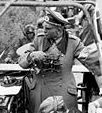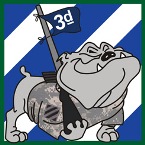malfid
Posts: 30
Joined: 3/20/2010
Status: offline

|
quote:
You're preaching to the choir when it comes to saying the first winter offensive was a failure considering what Stalin intended to do.
I spend a lot of time preaching to choirs. 
quote:
I was talking about the entire war in the East until mid-late 1943 more or less being a backhand blow on a nationwide scale.
I see what you're saying - and in an overall sense I can agree - but from the historical perspective you will forgive my reluctance! 
quote:
Panzer divisions were indeed not ideal for defence, especially not in difficult terrain, but if what you're facing is a giant wave of men coming at you, barely supported by armour, the battle quickly turns into a machine gunner's dream, and tanks are of course effective anti-infantry weapons when deployed against non-entrenched infantry.
My thoughts on this should perhaps go elsewhere (my profuse apologies, PyleDriver, I promise that this is my last post on the topic! Your AAR is excellent!), but I would venture the following:
1) German tanks of the war, especially, could in fact be characterized as extremely poor anti-infantry weapons. The Wehrmacht at no point emphasized HE capability for tanks in the same manner as the Soviets did (i.e. compare the HE ability of Soviet 76.2mm against German 75mm, and respective ammo loads of HE/AP). Their MMGs were extraordinarily limited in terms of ammunition and flexibility. The observability of surrounding terrain and small targets (say, for example, infantry) was low.
2) 240,000 riflemen in eight Rifle Corps - judged from afar - does, indeed, constitute a giant wave of men. But one cannot envision such a battlefield/zone of operations as flat grassland with few, if any, obstructions or terrain features. Rather, one must imagine an echeloned advance by tactical groups of infantry supported by enormous volumes of firepower (in this case, 5,000 guns), aviation (Il2s would greatly appreciate entrenched/buttoned up German armor refraining from maneuver) and utilizing terrain features to advance into the tactical zone unobserved. If confronted by armored pillboxes (this is what those tanks would amount to, in such an anti-infantry scenario), Soviet AT guns would be wheeled into direct fire positions from the third echelon, and would act as 'can openers'. AT rifles and grenades would further complicate the lives of the tankers in question. Logically, I concede, it does sound like a machinegunner's dream... In practice, though, I'm simply not sure.
quote:
Hitler often specifically ordered reserves to stay at the actual front, instead of the main line of defence which should be about 12 kilometres to the rear of the first line of defences according to German defensive doctrine, with mobile forces possibly being stationed even further to the rear.
Interestingly enough, this was often not the case. The Vistula-Oder Operation, for example, saw the initial penetration frustrated (though still successfully conducted) because the Soviets were unsure as to the German deployment. In this case, the German MLR (the echelon of which can vary) proved to be the third defensive belt, rather than the frontline. In that instance, the Soviets spent great quantities of ammunition and time bombarding empty trenches. Ditto for the Berlin operation (Seelow Heights). Hitler at times involved himself in battalion-level deployment - but only very rarely. He was more likely to order an area held, rather than a particular defensive line. In any case, the concentration of German forces in the first line was, to my knowledge, very uncommon...
quote:
If you place armoured formations directly at the front, they can't really respond to threats outside the sector they are covering.
Absolutely. Which is why I can only imagine that battle result if I envision it as a case of a pair of PzDs maneuvering against that Soviet force! Although, that introduces other logical difficulties.
But, really, I'm just being retentive. 
|
 Printable Version
Printable Version




























 New Messages
New Messages No New Messages
No New Messages Hot Topic w/ New Messages
Hot Topic w/ New Messages Hot Topic w/o New Messages
Hot Topic w/o New Messages Locked w/ New Messages
Locked w/ New Messages Locked w/o New Messages
Locked w/o New Messages Post New Thread
Post New Thread